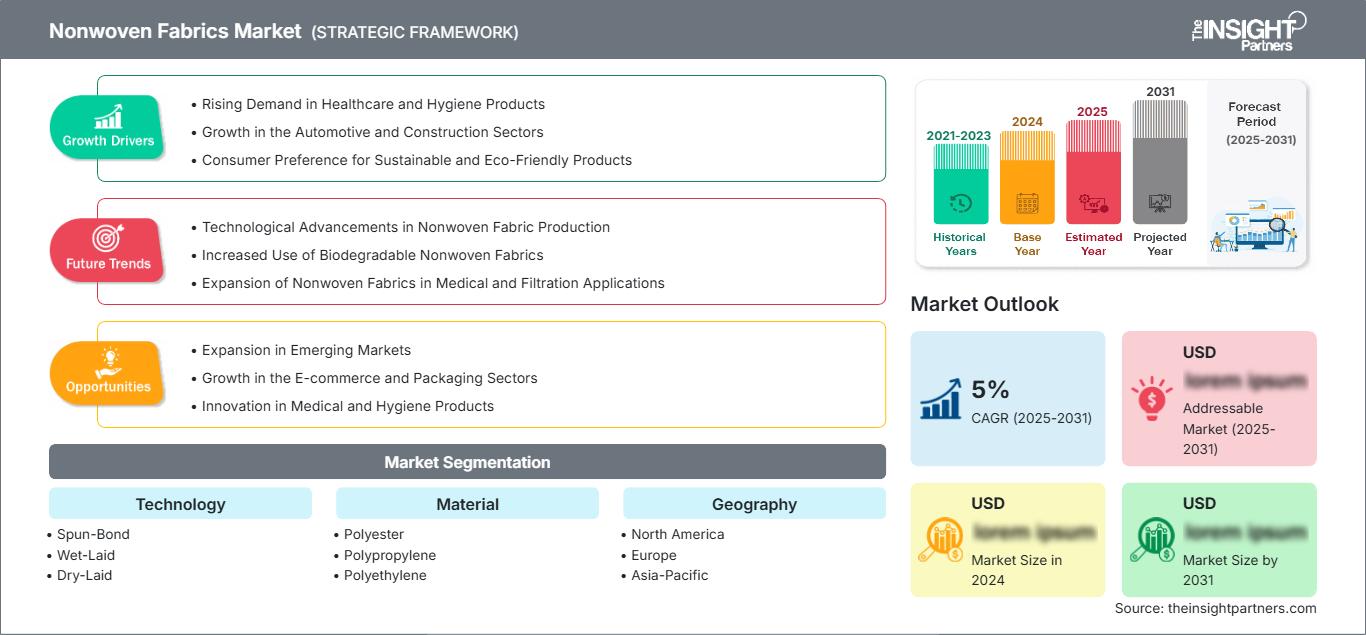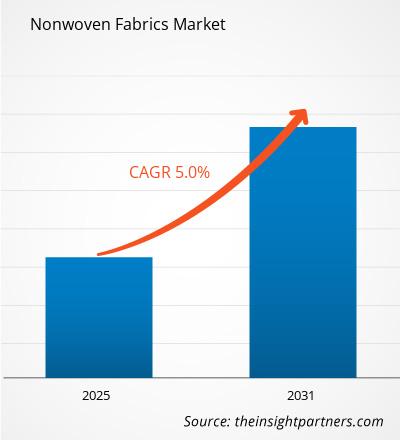预计 2025 年至 2031 年期间无纺布市场复合年增长率为 5%,市场规模将从 2024 年的 XX 百万美元扩大到 2031 年的 XX 百万美元。
无纺布市场规模和预测(2021-2031 年)、全球和区域增长机会分析、技术(纺粘、湿法成网、干法成网和其他技术)、材料(聚酯、聚丙烯、聚乙烯、人造丝和其他材料)、最终用户行业(建筑、纺织、医疗保健、汽车和其他最终用户行业)和地理区域(北美、欧洲、亚太地区、中东和非洲以及南美和中美)。无纺布是一种不同于传统机织或针织物的纺织材料。它们通过粘合或缠结纤维或长丝而不是挥动或编织它们来制造。无纺布可以由天然纤维、合成纤维或两者混合制成。
报告目的
The Insight Partners 撰写的《无纺布市场》报告旨在描述当前市场格局和未来增长、主要驱动因素、挑战和机遇。这将为各业务利益相关者提供见解,例如:
- 技术提供商/制造商:了解不断变化的市场动态并掌握潜在的增长机会,使他们能够做出明智的战略决策。
- 投资者:对市场增长率、市场财务预测以及整个价值链中存在的机遇进行全面的趋势分析。
- 监管机构:规范市场政策和警务活动,以最大程度地减少滥用行为,维护投资者的信任和信心,并维护市场的完整性和稳定性。
无纺布市场细分技术
- 纺粘
- 湿法成网
- 干法成网
- 其他技术
材料
- 聚酯
- 聚丙烯
- 聚乙烯
- 人造丝
- 其他材料
您将免费获得任何报告的定制,包括本报告的部分内容,或国家级分析、Excel 数据包,以及为初创企业和大学提供超值优惠和折扣
无纺布市场: 战略洞察

- 获取本报告的主要市场趋势。这个免费样本将包括数据分析,从市场趋势到估计和预测。
无纺布市场增长动力
- 医疗保健和卫生产品需求增长:医疗保健和卫生行业是无纺布市场增长的主要驱动力。无纺布通常用于医用口罩、防护服、尿布、卫生巾和伤口护理产品等产品。随着全球卫生意识的增强,以及新冠疫情导致个人防护设备 (PPE) 需求激增,医疗保健应用领域的无纺布市场显著扩张。随着医疗保健行业的不断发展和演变,对无纺布的需求也将随之增长。
- 汽车和建筑行业的增长:汽车和建筑行业是推动无纺布需求增长的关键行业。在汽车行业,无纺布用于各种应用,包括汽车内饰、隔热材料、过滤器和隔音材料。同样,在建筑行业,无纺布还用于土工布、屋顶材料和隔热材料。随着城市化、基础设施建设和汽车产量的增加,这些行业持续推动着对无纺布的需求。
- 消费者对可持续和环保产品的偏好:人们越来越倾向于选择可持续和环保产品,这推动了对由天然和可生物降解材料制成的无纺布的需求。随着越来越多的消费者和行业将环境责任放在首位,无纺布,尤其是由竹子、棉花和再生 PET 等可持续纤维制成的无纺布,正受到越来越多的关注。在包装、服装和其他消费品中,减少浪费和采用可回收材料是推动这一需求的因素。
无纺布市场未来趋势
- 无纺布生产的技术进步:重大的技术创新正在提高无纺布的生产能力,从而提高性能和效率。纺粘、熔喷和针刺等新制造技术使织物具有更好的强度、耐用性和防水性。这些进步正在拓展无纺布的潜在应用领域,使其对汽车、卫生和建筑等各个行业更具吸引力。
- 可生物降解无纺布的使用增加:随着人们对环境问题的日益关注,生产和使用可生物降解无纺布的趋势明显。这些织物由黄麻、大麻和棉花等天然纤维或生物聚合物制成,为合成无纺布材料提供了环保替代品。无纺布生产向可持续性转变的趋势日益普遍,这与全球减少塑料垃圾和碳足迹的努力相一致。
- 无纺布在医疗和过滤应用领域的扩展:医疗应用(包括外科口罩、伤口护理产品和医用长袍)对无纺布的需求激增,尤其是在应对 COVID-19 疫情期间。此外,由于无纺布具有高过滤效率,其在空气和水过滤产品中的应用也日益广泛。医疗保健行业在卫生和防护产品中对无纺布的依赖日益增加,加之人们对环境问题的日益关注推动了对更优质过滤解决方案的需求,这些都加剧了这一趋势。
无纺布市场机遇
- 新兴市场的扩张:新兴经济体,尤其是亚太、拉丁美洲和非洲的新兴经济体,为无纺布制造商带来了巨大的增长机会。随着这些地区经历工业化、城镇化和可支配收入的提高,医疗保健、卫生、汽车和建筑等领域对无纺布的需求预计将会增加。制造商可以利用这些地区不断壮大的中产阶级以及对现代基础设施和消费品日益增长的需求。
- 电子商务和包装行业的增长:随着电子商务的快速增长,对可持续和保护性包装材料的需求也日益增长。无纺布因其轻质、耐用和环保的特性,在包装应用领域拥有巨大的应用机会。专注于利用无纺布材料开发创新包装解决方案的公司,可以充分利用不断扩张的电子商务和零售市场,这些市场正转向可持续的包装替代品。
- 医疗和卫生产品创新:医疗和卫生行业为无纺布制造商提供了丰厚的机遇。全球日益增长的医疗保健需求,尤其是在应对疫情等健康危机的背景下,推动了医疗一次性用品、个人防护装备和卫生用品对无纺布的需求。医用无纺布的创新,例如抗菌性能和增强的液体阻隔能力,提供了进一步的增长潜力。此外,全球对卫生和卫生用品的持续关注,也使得尿布、女性卫生用品和成人失禁产品对先进无纺布材料的需求持续增长。
无纺布市场区域洞察
The Insight Partners 的分析师已详尽阐述了预测期内影响非织造布市场的区域趋势和因素。本节还探讨了北美、欧洲、亚太地区、中东和非洲以及南美和中美洲的非织造布市场细分和地域分布。
无纺布市场报告范围
| 报告属性 | 细节 |
|---|---|
| 市场规模 2024 | US$ XX million |
| 市场规模 2031 | US$ XX Million |
| 全球复合年增长率 (2025 - 2031) | 5% |
| 历史数据 | 2021-2023 |
| 预测期 | 2025-2031 |
| 涵盖的领域 |
By 技术
|
| 覆盖地区和国家 | 北美
|
| 市场领导者和主要公司简介 |
|
无纺布市场参与者密度:了解其对业务动态的影响
无纺布市场正在快速增长,这得益于终端用户需求的不断增长,而这些需求的驱动因素包括消费者偏好的不断变化、技术进步以及对产品优势的认知度不断提高。随着需求的增长,企业正在扩展产品线,不断创新以满足消费者需求,并抓住新兴趋势,从而进一步推动市场增长。

- 获取 无纺布市场 主要参与者概述
主要卖点
- 全面覆盖:本报告全面分析了无纺布市场的产品、服务、类型和最终用户,提供了全面的市场概况。
- 专家分析:本报告基于对行业专家和分析师的深入了解而编写。
- 最新信息:本报告涵盖了最新信息和数据趋势,确保了其业务相关性。
- 定制选项:本报告可根据特定客户需求进行定制,并使其与业务战略相得益彰。
因此,这份关于无纺布市场的研究报告有助于引领解读和理解行业情景和增长前景的步伐。尽管可能存在一些合理的担忧,但本报告的总体优势往往大于劣势。
- 历史分析(2 年)、基准年、预测(7 年)及复合年增长率
- PEST和SWOT分析
- 市场规模、价值/数量 - 全球、区域、国家
- 行业和竞争格局
- Excel 数据集
近期报告
客户评价
购买理由
- 明智的决策
- 了解市场动态
- 竞争分析
- 客户洞察
- 市场预测
- 风险规避
- 战略规划
- 投资论证
- 识别新兴市场
- 优化营销策略
- 提升运营效率
- 顺应监管趋势




















 获取免费样品 - 无纺布市场
获取免费样品 - 无纺布市场